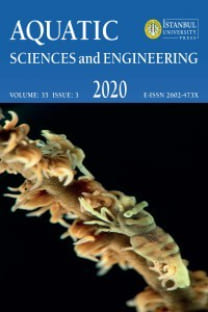Bio-designing of Culture Conditions for Chlorella vulgaris Using Response Surface Methodology
Microalgae are microscopic organisms and show a geographical distribution depending on the physical, dynamic, and chemical factors of the environment. These factors are mostly important for attachment and development of microalgae. Substrate, temperature, light, agitation, and turbidity can be given as examples of physical factors, whereas salinity, pH value, and vitamins can be categorized as chemical factors. In this study, the optimization of Chlorella vulgaris production was carried out by response surface methodology (RSM) using two factors of agitation rate (100-250 rpm) and nitrogen source concentration (1-4 g/L) in the cultivation of BG11 medium. Moreover, the usage of urea instead of NaNO3 was investigated and discussed.
Keywords:
Chlorella vulgaris, Response surface methodology Optimization, Urea,
___
- Barkia, I., Saari, N., & Manning, S. R. (2019) Microalgae for high-value products towards human health and nutrition, Marine Drugs, 17(5), 304-305. [CrossRef]
- Becker, E. (2007) Micro-algae as a source of protein, Biotechnology Advances, 25(2), 207-210. [CrossRef]
- Chisti, Y. (2007) Biodiesel from microalgae, Biotechnology Advances, 25(3), 294-306. [CrossRef]
- Converti, A., Casazza, A. A., Ortiz, E. Y., Perego, P., & Del Borghi, M. (2009) Effect of temperature and nitrogen concentration on the growth and lipid content of Nannochloropsis oculata and Chlorella vulgaris for biodiesel production, Chemical Engineering and Processing: Process Intensification, 48(6), 1146-1151. [CrossRef]
- Deniz, I., İmamoğlu, E., & Dalay, M. C. (2015) Optimization of physical parameters for phycobiliprotein extracted from Oscillatoria agardhii and Synechococcus nidulans/Oscillatoria agardhii ve Synechococcus nidulans türlerinden fikobiliprotein ekstraksiyonu için fiziksel parametrelerin optimizasyonu, Turkish Journal of Biochemistry, 40(6), 481-491. [CrossRef]
- Fermoso, J., Gil, M. V., Arias, B., Plaza, M. G., Pevida, C., Pis, J., & Rubiera, F. (2010) Application of response surface methodology to assess the combined effect of operating variables on high-pressure coal gasification for H2-rich gas production, International Journal of Hydrogen Energy, 35(3), 1191-1204. [CrossRef]
- Guo, J., Zhuang, Y., Chen, L., Liu, J., Li, D., & Ye, N. (2012) Process optimization for microwave-assisted direct liquefaction of Sargassum polycystum C. Agardh using response surface methodology, Bioresource Technology, 120, 19-25. [CrossRef]
- Hanrahan, G., Garza, C., Garcia, E., & Miller, K. (2007) Experimental design and response surface modeling: A method development application for the determination of reduced inorganic species in environmental samples, Journal of Environmental Informatics, 9(2). [CrossRef]
- Hariskos, I., & Posten, C. (2014) Biorefinery of microalgae–opportunities and constraints for different production scenarios, Biotechnology Journal, 9(6), 739-752. [CrossRef]
- Imamoglu, E., Demirel, Z., & Dalay, M. C. (2014) A response surface methodology study for the protein production of Chlorella sp. Int J Adv Chem Engg Biol Sci (IJACEBS), 1, 76-79.
- Jaliliannosrati, H., Amin, N. A. S., Talebian-Kiakalaieh, A., & Noshadi, I. (2013) Microwave assisted biodiesel production from Jatropha curcas l seed by two-step in situ process: Optimization using response surface methodology, Bioresource Technology, 136, 565-573. [CrossRef]
- Khan, M. I., Shin, J. H., & Kim, J. D. (2018) The promising future of microalgae: Current status, challenges, and optimization of a sustainable and renewable industry for biofuels, feed, and other products, Microbial Cell Factories, 17(1), 36. [CrossRef]
- Kong, W. B., Hua, S. F., Cao, H., Mu, Y. W., Yang, H., Song, H., & Xia, C. G. (2012) Optimization of mixotrophic medium components for biomass production and biochemical composition biosynthesis by Chlorella vulgaris using response surface methodology, Journal of the Taiwan Institute of Chemical Engineers, 43(3), 360-367. [CrossRef]
- Mazaheri, H., Lee, K. T., Bhatia, S., & Mohamed, A. R. (2010) Subcritical water liquefaction of oil palm fruit press fiber for the production of bio-oil: Effect of catalysts, Bioresource Technology, 101(2), 745-751. [CrossRef]
- Montgomery, D. C. (2001) Design And Analysis Of Experiments. John Wiley & Sons. Inc., New York. Myers, R. H., Montgomery, D. C., & Anderson-Cook, C. M. (2016) Response surface methodology: Process and product optimization using designed experiments. John Wiley & Sons Inc., New York.
- Priyadarshani, I., & Rath, B. (2012) Commercial and industrial applications of micro algae–a review, Journal of Algal Biomass Utilization, 3(4), 89-100.
- Razack, S. A., Duraiarasan, S., Shellomith, A. S., & Muralikrishnan, K. (2015) Statistical optimization of harvesting Chlorella vulgaris using a novel bio-source, strychnos potatorum, Biotechnology Reports, 7, 150-156. [CrossRef]
- Sacasa Castellanos, C. (2013) Batch and continuous studies of Chlorella vulgaris in photo-bioreactors, Electronic Thesis and Dissertation Repository, 1113.
- Stolz, P., & Obermayer, B. (2005) Manufacturing microalgae for skin care, Cosmetics and Toiletries, 120(3), 99-106.
- Støttrup, J., & McEvoy, L. (2008) Live feeds in marine aquaculture. John Wiley & Sons. Inc., New York.
- Tam, N., & Wong, Y. (1996). Effect of ammonia concentrations on growth of Chlorella vulgaris and nitrogen removal from media, Bioresource Technology, 57(1), 45-50. [CrossRef]
- Xie, T., Sun, Y., Du, K., Liang, B., Cheng, R., & Zhang, Y. (2012) Optimization of heterotrophic cultivation of Chlorella sp. for oil production, Bioresource Technology, 118, 235-242. [CrossRef]
- Yeh, K. L., Chang, J. S., & Chen, W. M. (2010) Effect of light supply and carbon source on cell growth and cellular composition of a newly isolated microalga Chlorella vulgaris esp-31, Engineering in Life Sciences, 10(3), 201-208. [CrossRef]
- Yayın Aralığı: Yılda 4 Sayı
- Başlangıç: 1987
- Yayıncı: İstanbul Üniversitesi
